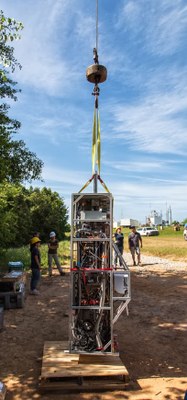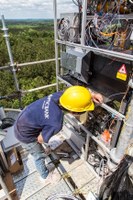Southeast Atmosphere Study (SAS): Unlocking Air Pollution Secrets and the Impacts on Climate Change
Participating in the SOAS project from Penn State are Dr, Bill Brune, David Miller (Researcher), Li Zhang (Graduate Student), and Philip Feiner (Undergrad).
This is an unprecedented collaboration of five projects addressing various components of air quality, chemical and aerosol constituent evolution over the SE US. The synergy of these projects build on the success of studies such as the Southern Oxidant Study (SOS) of the 1990s in the same region. The atmospheric chemistry community, via the synergy and collaborative analysis of data from SAS, is poised to uncover the controlling processes of biosphere-atmosphere interactions that affect regional climate and air quality in the SE US.
 From June 1-July 15, University and Federal scientists will investigate why and how the Southeast U.S. has not warmed similar to the rest of the continental U.S. and the globe. A combined investment of more than $20 million will include deployment of major measurement facilities including the NSF/NCAR C-130 and NOAA P3 sampling across the region from the Mississippi River to the Atlantic Ocean and from the Ohio River Valley to the Gulf of Mexico; an Integrated sounding system (ISS) measuring boundary layer winds, moisture and temperature gradients; as well flux and chemical platform towers with instrumentation to take high resolution measurements from the surface up to 45m within the forest canopy and in the air above the forest.
From June 1-July 15, University and Federal scientists will investigate why and how the Southeast U.S. has not warmed similar to the rest of the continental U.S. and the globe. A combined investment of more than $20 million will include deployment of major measurement facilities including the NSF/NCAR C-130 and NOAA P3 sampling across the region from the Mississippi River to the Atlantic Ocean and from the Ohio River Valley to the Gulf of Mexico; an Integrated sounding system (ISS) measuring boundary layer winds, moisture and temperature gradients; as well flux and chemical platform towers with instrumentation to take high resolution measurements from the surface up to 45m within the forest canopy and in the air above the forest.
 An international team of investigators will bring an unprecedented suite of chemical species filter sampling equipment and in-situ sensors to characterize the atmosphere and the chemical processes occurring within it at sites across the Southeast US during this summer. The main ‘super site’ brings ~100 participants and ~50 specialized samplers and analyzers to the SouthEastern Aerosol and Atmospheric Characterization (SEARCH) Network site near Brent, Alabama. Complementary sites at Look Rock, TN in the Great Smoky Mountains, Research Triangle Park, NC and the Alabama Aquatic Biodiversity Center near Marion Alabama will be making chemical, atmospheric and related flux observations as well radiation measurements as scientists attempt to characterize the content, form and evolution of chemical and aerosol species in the humid Southeast US during summer.
An international team of investigators will bring an unprecedented suite of chemical species filter sampling equipment and in-situ sensors to characterize the atmosphere and the chemical processes occurring within it at sites across the Southeast US during this summer. The main ‘super site’ brings ~100 participants and ~50 specialized samplers and analyzers to the SouthEastern Aerosol and Atmospheric Characterization (SEARCH) Network site near Brent, Alabama. Complementary sites at Look Rock, TN in the Great Smoky Mountains, Research Triangle Park, NC and the Alabama Aquatic Biodiversity Center near Marion Alabama will be making chemical, atmospheric and related flux observations as well radiation measurements as scientists attempt to characterize the content, form and evolution of chemical and aerosol species in the humid Southeast US during summer.
A web site dedicated to the projects, the deployment and measurement plans as well as observation summaries and preliminary data products can be found at:

